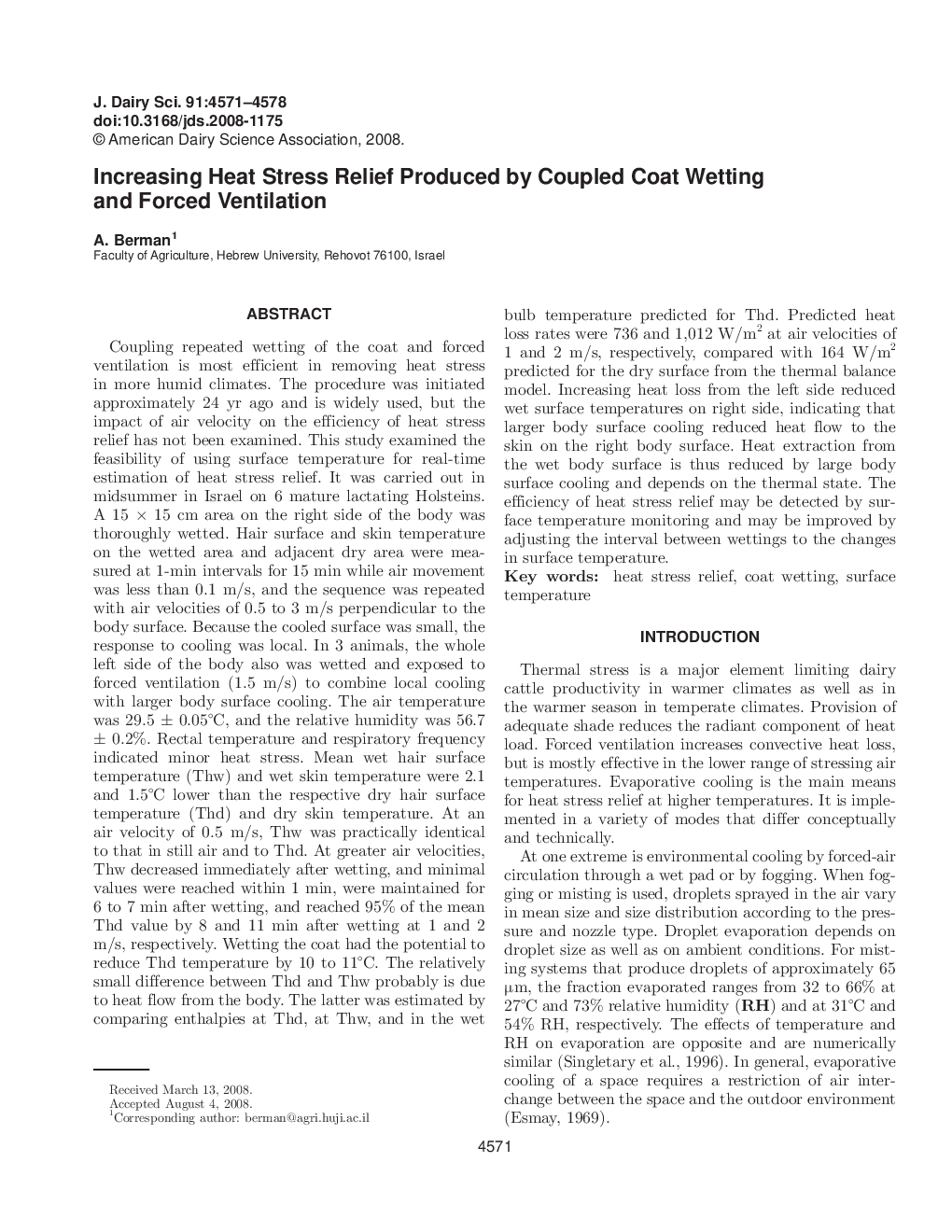| کد مقاله | کد نشریه | سال انتشار | مقاله انگلیسی | نسخه تمام متن |
|---|---|---|---|---|
| 2439793 | 1108105 | 2008 | 8 صفحه PDF | دانلود رایگان |
عنوان انگلیسی مقاله ISI
Increasing Heat Stress Relief Produced by Coupled Coat Wetting and Forced Ventilation
دانلود مقاله + سفارش ترجمه
دانلود مقاله ISI انگلیسی
رایگان برای ایرانیان
کلمات کلیدی
موضوعات مرتبط
علوم زیستی و بیوفناوری
علوم کشاورزی و بیولوژیک
علوم دامی و جانورشناسی
پیش نمایش صفحه اول مقاله

چکیده انگلیسی
Coupling repeated wetting of the coat and forced ventilation is most efficient in removing heat stress in more humid climates. The procedure was initiated approximately 24 yr ago and is widely used, but the impact of air velocity on the efficiency of heat stress relief has not been examined. This study examined the feasibility of using surface temperature for real-time estimation of heat stress relief. It was carried out in midsummer in Israel on 6 mature lactating Holsteins. A 15 Ã 15 cm area on the right side of the body was thoroughly wetted. Hair surface and skin temperature on the wetted area and adjacent dry area were measured at 1-min intervals for 15 min while air movement was less than 0.1 m/s, and the sequence was repeated with air velocities of 0.5 to 3 m/s perpendicular to the body surface. Because the cooled surface was small, the response to cooling was local. In 3 animals, the whole left side of the body also was wetted and exposed to forced ventilation (1.5 m/s) to combine local cooling with larger body surface cooling. The air temperature was 29.5 ± 0.05°C, and the relative humidity was 56.7 ± 0.2%. Rectal temperature and respiratory frequency indicated minor heat stress. Mean wet hair surface temperature (Thw) and wet skin temperature were 2.1 and 1.5°C lower than the respective dry hair surface temperature (Thd) and dry skin temperature. At an air velocity of 0.5 m/s, Thw was practically identical to that in still air and to Thd. At greater air velocities, Thw decreased immediately after wetting, and minimal values were reached within 1 min, were maintained for 6 to 7 min after wetting, and reached 95% of the mean Thd value by 8 and 11 min after wetting at 1 and 2 m/s, respectively. Wetting the coat had the potential to reduce Thd temperature by 10 to 11°C. The relatively small difference between Thd and Thw probably is due to heat flow from the body. The latter was estimated by comparing enthalpies at Thd, at Thw, and in the wet bulb temperature predicted for Thd. Predicted heat loss rates were 736 and 1,012 W/m2 at air velocities of 1 and 2 m/s, respectively, compared with 164 W/m2 predicted for the dry surface from the thermal balance model. Increasing heat loss from the left side reduced wet surface temperatures on right side, indicating that larger body surface cooling reduced heat flow to the skin on the right body surface. Heat extraction from the wet body surface is thus reduced by large body surface cooling and depends on the thermal state. The efficiency of heat stress relief may be detected by surface temperature monitoring and may be improved by adjusting the interval between wettings to the changes in surface temperature.
ناشر
Database: Elsevier - ScienceDirect (ساینس دایرکت)
Journal: Journal of Dairy Science - Volume 91, Issue 12, December 2008, Pages 4571-4578
Journal: Journal of Dairy Science - Volume 91, Issue 12, December 2008, Pages 4571-4578
نویسندگان
A. Berma,